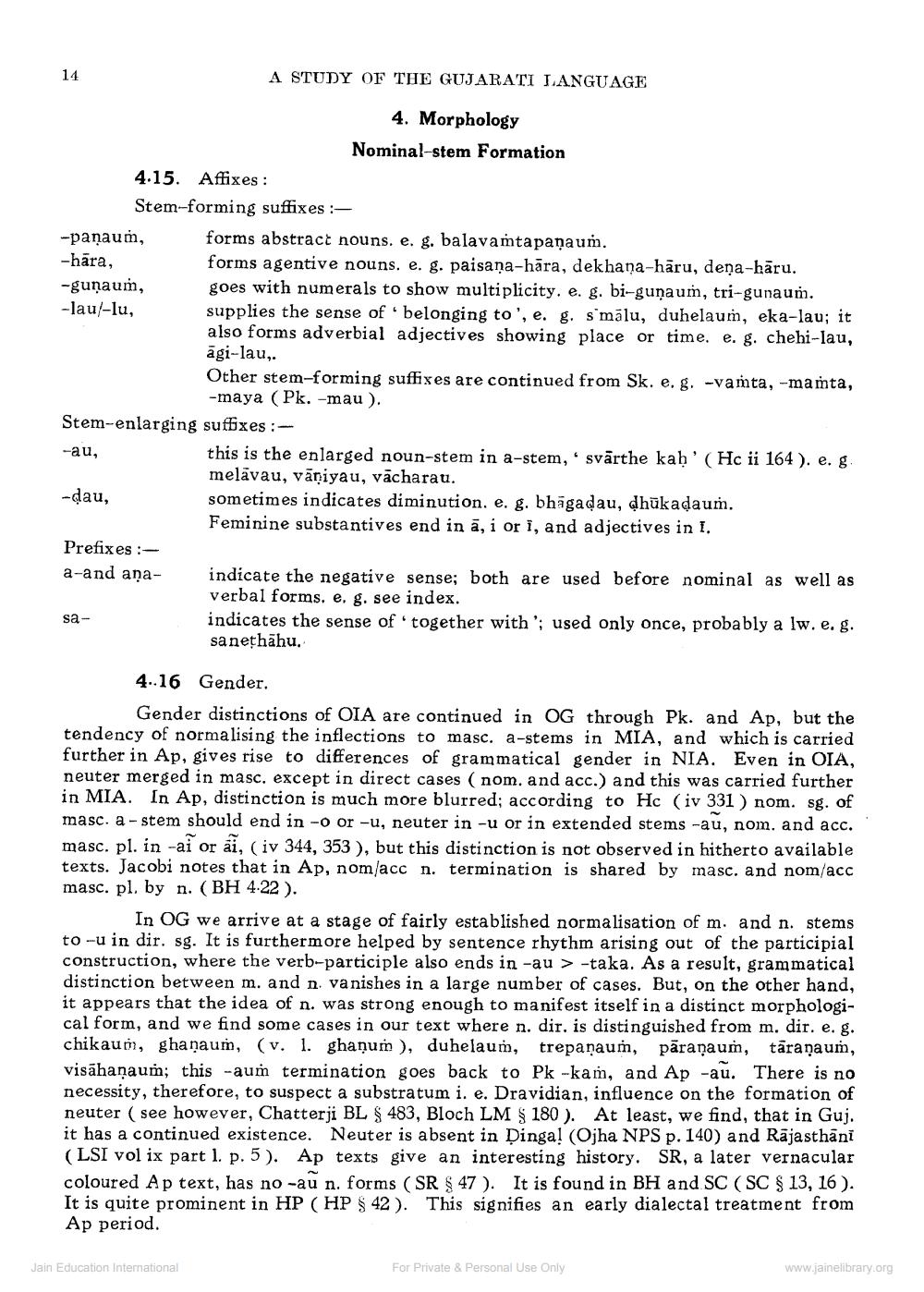________________
A STUDY OF THE GUJARATI LANGUAGE
4. Morphology
Nominal-stem Formation 4.15. Affixes:
Stem--forming suffixes :-paņaum, forms abstract nouns. e. g. balavamtapaņaum. -hāra,
forms agentive nouns. e. g. paisana-hāra, dekhana-hāru, dena-hāru. -gunaum, goes with numerals to show multiplicity. e. g. bi-gunaum, tri-gunaum. -lau/-lu, supplies the sense of belonging to', e. g. s mālu, duhelaum, eka-lau; it
also forms adverbial adjectives showing place or time. e. g. chehi-lau, āgi-lau, Other stem-forming suffixes are continued from Sk. e. g. -vamta, -mamta,
-maya (Pk. -mau ). Stem-enlarging suffixes :-au,
this is the enlarged noun-stem in a-stem, svārthe kah' (Hc ii 164 ). e. g
melāvau, vāniyau, vācharau. -dau,
sometimes indicates diminution. e. g. bhāgadau, dhūkadaum.
Feminine substantives end in ā, i or i, and adjectives in I. Prefixes :a-and ana- indicate the negative sense; both are used before nominal as well as
verbal forms. e. g. see index. sa
indicates the sense of together with '; used only once, probably a lw.e. g. sa nethāhu.
4..16 Gender.
Gender distinctions of OIA are continued in OG through Pk. and Ap, but the tendency of normalising the inflections to masc. a-stems in MIA, and which is carried further in Ap, gives rise to differences of grammatical gender in NIA. Even in OIA, neuter merged in masc, except in direct cases (nom. and acc.) and this was carried further in MIA. In Ap, distinction is much more blurred; according to Hc (iv 331 ) nom. sg. of masc. a - stem should end in -o or-u, neuter in -u or in extended stems -au, nom. and acc. masc. pl. in -ai or ai, (iv 344, 353 ), but this distinction is not observed in hitherto available texts. Jacobi notes that in Ap, nom/acc n. termination is shared by masc. and nom/acc masc. pl. by n. (BH 4.22).
In OG we arrive at a stage of fairly established normalisation of m. and n. stems to-u in dir. sg. It is furthermore helped by sentence rhythm arising out of the participial construction, where the verb--participle also ends in -au > -taka. As a result, grammatical distinction between m. and n va nishes in a large number of cases. But, on the other hand, it appears that the idea of n. was strong enough to manifest itself in a distinct morphological form, and we find some cases in our text where n. dir. is distinguished from m. dir. e. g. chikauni, ghanaum, (v. 1. ghanum), duhelaum, trepanaum, pāranaum, tāranaum, visāhanaum; this -aum termination goes back to Pk -kam, and Ap -au. There is no necessity, therefore, to suspect a substratum i. e. Dravidian, influence on the formation of neuter (see however, Chatterji BL § 483, Bloch LM $ 180 ). At least, we find, that in Guj. it has a continued existence. Neuter is absent in Dinga! (Ojha NPS p. 140) and Rajasthani (LSI vol ix part 1. p. 5). Ap texts give an interesting history. SR, a later vernacular coloured Ap text, has no -au n. forms (SR $ 47). It is found in BH and SC (SC $ 13, 16). It is quite prominent in HP (HP S 42). This signifies an early dialectal treatment from Ap period.
Jain Education International
For Private & Personal Use Only
www.jainelibrary.org




